Join us at the International Thermal Conductivity Conference (ITCC) and the International Thermal Expansion Symposium (ITES).
Geological
Nanomaterials
Pastes
Pastes
Polymers
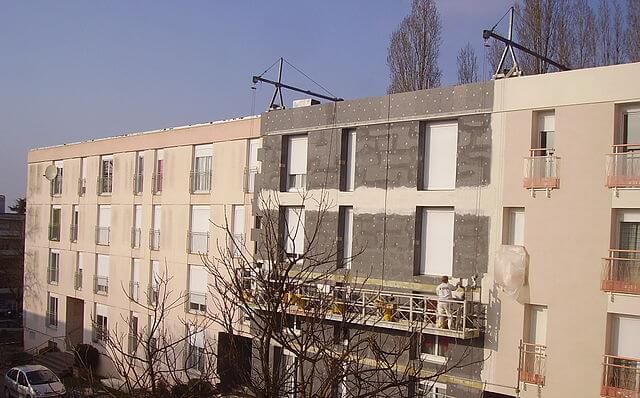
Figure 1. Acrylic plaster being applied on EPS insulation boards, on an apartment building façade.1
Extruded Polystyrene is a highly insulative construction material, generally installed on the exterior of above-grade studded walls, or the interior of foundation walls. Thus, knowing extruded polystyrene thermal conductivity values is important when determining the insulative potential of a building. Its purpose is to serve as a defense mechanism for heat loss in buildings, aiming at reducing the cost of operation. Extruded polystyrene is often confused with expanded polystyrene. Although similar in some aspects, such as their composition (polymerized polystyrol), these two insulation materials are vastly different. Extruded polystyrene is created by a process referred to as extrusion, hence the name. During this process, the polystyrol material is extruded through a die, causing the material to expand into a uniform closed-cell insulation board (Figure 2). Expanded polystyrene on the other hand is created by placing small foam beads into a mold and applying steam to expand the beads to form an insulation board (Figure 2). The manufacturing process of expanded polystyrene creates voids between the foam beads, creating pathways for potential moisture to enter.
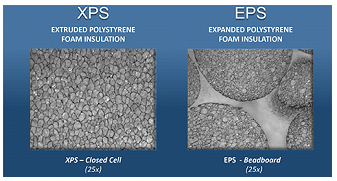
Figure 2. Microscopic differences between the composition of extruded (left) and expanded (right) polystyrene foam insulations.2
Extruded Polystyrene Thermal Conductivity
The Thermtest Heat Flow Meter (HFM) is a steady-state heat transfer system measuring the thermal conductivity and thermal resistivity of flat slab insulating materials such as foams, solids and textiles (Figure 3). The HFM measures thermal conductivity over a range of 0.005 to 0.5 W/m·K and over a temperature range of -20°C to 70°C, in accordance with ASTM C518-15 – Standard Test Method for Steady-State Thermal Transfer Properties by Means of the Heat Flow Meter Apparatus. Users can expect a high degree of accuracy (3%) and precision (0.5%) with this ASTM traceable measurement technique.
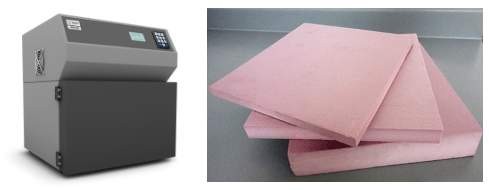
Figure 3. Thermtest Heat Flow Meter (left) and samples of various thicknesses to test extruded polystyrene thermal conductivity (right).
According to the ASTM C518-15, to ensure the proper performance of the HFM, the apparatus must be calibrated with materials having similar thermal conductivities and thicknesses as the materials to be evaluated. If the calibration standard is tested at one thickness, the heat flow meter apparatus can be calibrated for that thickness. However, if tests are to be performed at varying thicknesses other than the calibrated thickness, a thorough study of the error of the HFM at other thicknesses must be conducted. For this experiment, Thermtest researchers set out to test the accuracy boundaries of the HFM, by testing multiple sample thicknesses based off of only one calibration thickness.
To begin, the calibration sample (NIST SRM 1450d – 1″) was placed between two parallel plates within the HFM (Figure 4). A specified temperature gradient (10 – 30°C) across the plates was established to simulate heat loss from the internal environment of a building, to the colder external environment. The upper plate was then set to compress onto the specimen to an automatic sample thickness. The HFM automatically determines sample thickness by employing four digital encoders, located in each corner of the upper plate. Each digital encoder measures the thickness at their post, and then the average is calculated. The upper plate then automatically adjusts to the average height, delivering approximately 5 pounds per square inch of force onto the testing specimen. This automatic thickness gauge, has a precision accuracy of ~0.1m. If the testing sample is highly compressible and an approximate compression force is known, a manual thickness setting may be a more suitable option in receiving accurate and precise thermal conductivity results.
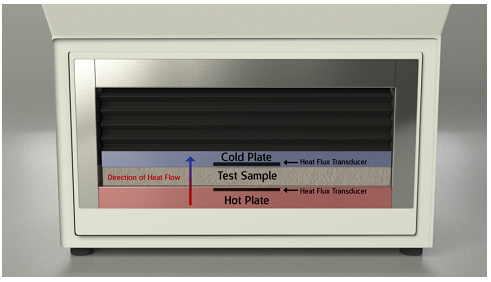
Figure 4. View from inside the HFM door. Parallel plates (red and blue) establish a one-dimensional heat flux through the test specimen, simulating heat loss from a building’s interior to the external environment.
At constant, but distinct temperatures, the parallel plates established a steady state, one-dimensional heat flux through the test specimen and the thermocouples embedded in each plate, measured the temperature on either side of the calibration specimen. The heat flux transducers, in contact with the upper and lower plates, collected data on the resulting heat flux of the test specimen (Figure 4). By appropriate calibration of the heat flux transducer(s) with standards, and by measuring the plate temperatures and plate separation, Fourier’s law of heat conduction is used to calculate thermal conductivity (λ):
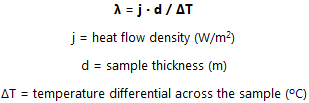 After the calibration was performed as mentioned above, each thickness of the extruded polystyrene sample was tested as per the steps outlined above.
After the calibration was performed as mentioned above, each thickness of the extruded polystyrene sample was tested as per the steps outlined above.
The objective of this experiment was to determine the accuracy of the Thermtest HFM to test the thermal conductivity of varying thicknesses of extruded polystyrene at 20°C, with a single calibration sample. Thermal conductivity readings received from tests performed on thicknesses varying between 10.1 mm and 40.4 mm were within reason of the thermal conductivity reading of the 25.2 mm control test (less than 3%) (Figure 5). The results achieved correlate with results received from an experiment performed by Al-Ajlan in 2006, as well as the manufacturer provided data.
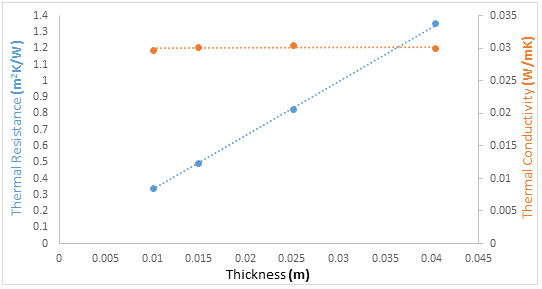
Figure 5. Thermal conductivity and thermal resistance values of various thicknesses of extruded polystyrene, calibrated against one layer of NIST SRM 1450d and performed at a mean temperature of 20˚C, using the Thermtest HFM.
Al-Ajlan (2006), reports the manufacturer provided thermal conductivity of expanded polystyrene to be 0.034 W/mK. This thermal conductivity is slightly higher than the manufacturer provided thermal conductivity of extruded polystyrene (0.032). Although extruded polystyrene has a lower thermal conductivity, meaning it is more likely to protect your internal environment from unwanted temperature changes, it has a significantly higher cost than the expanded polystyrene. Careful consideration must be taken into account when selecting the proper foam insulation board for your construction needs.
The Thermtest HFM is a fast, reliable and flexible method for testing thermal conductivities of solids, foams and textiles. Although not intended for use of testing various sample thicknesses with a single calibration thickness, this research proves the ability of the HFM to test the thermal conductivities of samples with slight variations in thicknesses, compared to the calibration sample.
The Thermtest Heat Flow Meter (HFM) provides users with the ability to measure thermal properties of larger, flat slab specimens ranging in thermal conductivities from 0.005 to 0.5 W/m∙K. The Heat Flow Meter is capable of measuring the steady-state heat transfer properties of foams, solids, and textiles.
References:
A.M. Papadopoulos. 2005. State of the art in thermal insulation materials and aims for future developments. Energy and Buildings, 37: 77–86. Available at: http://www.geolan.gr/sappek/docs/publications/article_8.pdf
J. Woestman. 2015. Selecting Polystyrene Foam Where Moisture Exposure Occurs. The Construction Specifier. Available at: http://www.constructionspecifier.com/selecting-polystyrene-foam-where-moisture-exposure-occurs/.
S. A. Al-Ajlan. 2006. Measurements of thermal properties of insulation materials by using transient plane source technique. Applied Thermal Engineering 26(17): 2184-2191. Available at: http://www.eyoungindustry.com/uploadfile/file/20151006/20151006163926_34665.pdf
ASTM C518-15, Standard Test Method for Steady-State Thermal Transmission Properties by Means of the Heat Flow Meter Apparatus, ASTM International, West Conshohocken, PA, 2015, www.astm.org
Image Reference: